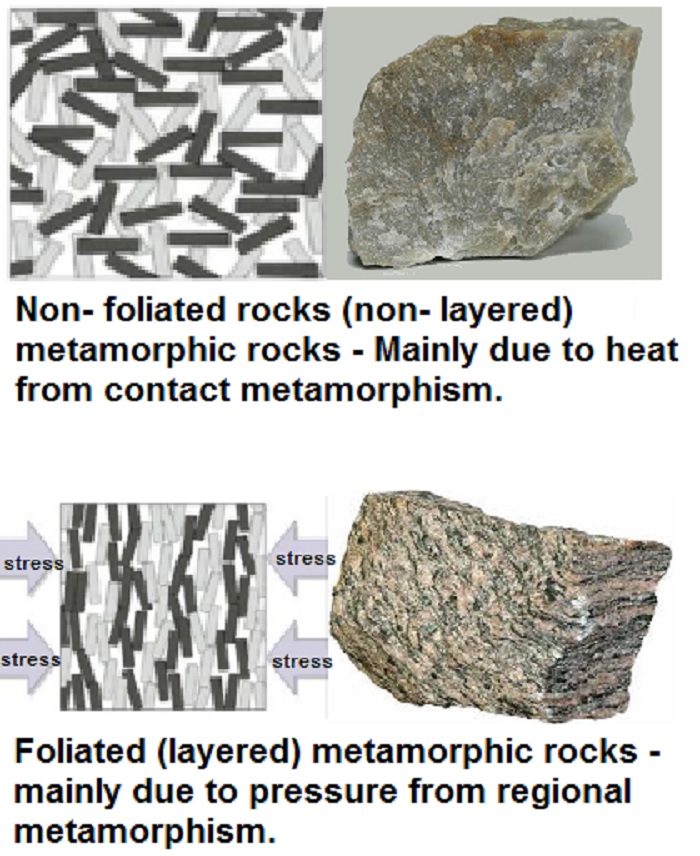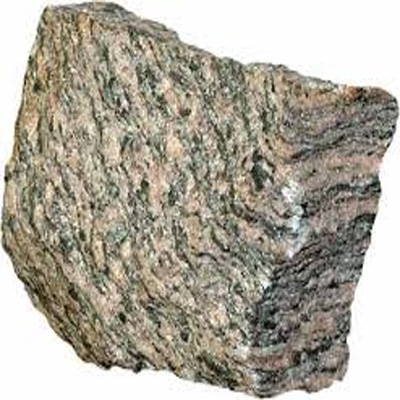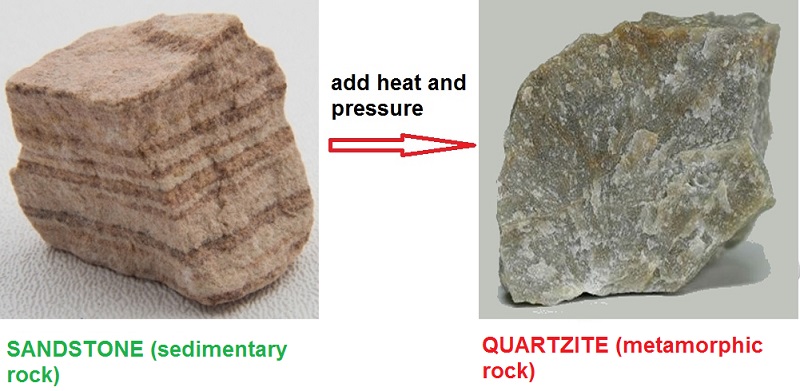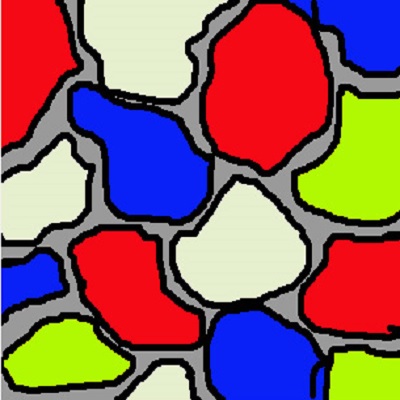METAMORPHIC ROCKS


|
Metamorphic Rocks -
Sedimentary rocks exposed to the effects of heat and pressure can undergo extensive chemical and physical changes. This alteration is referred to as metamorphism. The figure below shows a series of layered rocks consisting of sedimentary formations that have been cut by a dike (cross-cutting planar intrusion), and, at greater depth, intruded by a batholith (large intrusion). It is in situations like this that sedimentary layers can be metamorphosed due to their proximity to hot, molten rock from which chemically active solutions are released. Near the dike, rocks which further away are limestones have metamorphosed into marbles. Similarly, sandstones have become quartzites. In the vicinity of the batholith, the action of heat and chemical solutions is accompanied by pressure produced by the batholith as it forces its way upward. Horizontal rock layers exposed to such pressure are folded and deformed. The result is the highly contorted layering illustrated in the figure below. Such layering produced during metamorphism is called foliation. In such situations, rocks undergo varying degrees of metamorphism depending on their proximity to the batholith and to the intensity of deformation. Shales can be metamorphosed to slates, schists, and gneiss as metamorphic intensity increases.
|
|
|
|
|
|
|
|
|
|
|
|
|
|
|
|
|
|
|
|
|
Describe how the sandstone (sedimentary rock) and quartzite (metamorphic rock) differ visually from each other (aside from color). |
|
|
______________________________________________________________________________ |
|
|
______________________________________________________________________________ |
|
|
|
|
|
By looking at the grain arrangements of sandstone (on the left) and quartzite (on the right), which one do think it will be harder? |
|
|
|
|
|
______________________________________________________________________________ |
|
|
______________________________________________________________________________ |
|
|
|
|
|
What specifically happened during the metamorphism of the sandstone to quartzite to causes these differences? (think about the metamorphic settings) |
|
|
______________________________________________________________________________ |
|
|
______________________________________________________________________________ |
|
|
|
|
|
|
|
|
Describe the visual differences between the limestone (sedimentary rock) and the marble (metamorphic rock) (aside from color). |
|
|
______________________________________________________________________________ |
|
|
______________________________________________________________________________ |
|
|
|
|
|
Do you think that marble will react to hydrochloric acid? Why or why not? |
|
|
______________________________________________________________________________ |
|
|
|
|
|
What specifically happened during the metamorphism of the limestone to marble to causes these differences? (think about metamorphic settings) |
|
|
______________________________________________________________________________ |
|
|
______________________________________________________________________________ |
|
|
|
|
|
In addition to causing deformation of layering during metamorphism, pressure may actually produce layering during the formation of sedimentary rocks. For example, the sediment, mud, under pressure becomes shale, a sedimentary rock with a fairly distinct layering. Generally speaking, the sources of pressure producing layering during the formation of sedimentary rocks is not the same as that causing deformation and metamorphism. Examine the shale (sedimentary rock) specimen below. |
|
|
|
|
|
What force could act on mud to produce the pressure that results in this layering? |
|
|
______________________________________________________________________________ |
|
|
|
|
|
Examine the figure below. What evidence is there to indicate that the rocks have been subjected to deformation? |
|
|
|
|
|
______________________________________________________________________________ |
|
|
In this situation, what is it that has produced the pressure? |
|
|
______________________________________________________________________________ |
|
|
|
|
|
Describe the visual differences between shale (a sedimentary rock) and slate (a metamorphic). Can you explain these differences in terms of a metamorphic process? |
|
|
|
|
|
______________________________________________________________________________ |
|
|
______________________________________________________________________________ |
|
|
______________________________________________________________________________ |
|
|
|
|
|
Describe the visual differences between slate (metamorphic rock) and schist (metamorphic rock). |
|
|
|
|
|
______________________________________________________________________________ |
|
|
______________________________________________________________________________ |
|
|
Which of these two rocks has experienced a greater degree of metamorphism? Why? |
|
|
______________________________________________________________________________ |
|
|
______________________________________________________________________________ |
|
|
|
|
|
Examine and describe the specimen of gneiss (metamorphic rock). |
|
|
|
|
|
______________________________________________________________________________ |
|
|
______________________________________________________________________________ |
|
|
How is the gneiss similar to, yet different from, the schist? How do you think these differences might arise? |
|
|
|
|
|
______________________________________________________________________________ |
|
|
______________________________________________________________________________ |
|
|
______________________________________________________________________________ |
|
|
|
|
|
|
|
|
Metamorphic
rocks are either igneous or sedimentary that go to extensive chemical
and physical changes caused by the effects of heat and pressure.
|
|
|
Metamorphic
rocks are classified into two main groups: FOLIATED and NON- FOLIATED.
|
|
|
FOLIATED metamorphic rocks have banded or layered appearance. |
|
|
NON-FOLIATED
metamorphic rocks do not have band or layers.
|
|
 |
Name of rock = SLATE Type of rock = FOLIATED Parent rock = Shale underwent changes due to heat and pressure Characteristics = Thin closely packed layers/No crystals visible |
 |
Name of rock = SCHIST Type of rock = FOLIATED Parent rock = Slate underwent more changes due to more heat and pressure Characteristics = Thinner, broken up layers/Crystals are visible |
 |
Name of rock = GNEISS Type of rock = FOLIATED Parent rock = Schist underwent more changes due to more heat and pressure Characteristics = There is clear separation of minerals of bands or layers/Crystals are visible |
 |
Name of rock = QUARTZITE Type of rock = NON-FOLIATED Parent rock = Sandstone underwent changes due to heat and pressure Characteristics = Hard packed rock, sand grains are fused (welded) together/Crystals are visible |
 |
Name of rock = MARBLE Type of rock = NON-FOLIATED Parent rock = Limestone underwent changes due to heat and pressure Characteristics = Crystals are clearly visible, this rock will react to HCl |

©David Leveson and David Seidemann - Brooklyn College - Earth and Environmental Sciences










